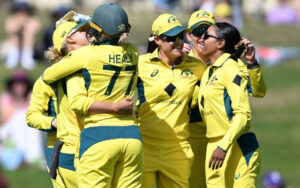Australia Women have made a strong start to the ongoing Ashes series, winning the first three ODIs. With six points already in their bag, they will aim to maintain their dominance in the upcoming T20Is and a Test match. England had their opportunities, especially in the second and third games, but it was Australia’s exceptional fielding that turned the tide. Their fielding efforts created chances out of nowhere, breaking partnerships and taking wickets against the run of play.

Fielding is a crucial aspect of cricket that can often be the difference between winning and losing. Outstanding fielding puts the opposition under pressure, forcing mistakes that ultimately lead to wickets. The Australian women’s team is widely admired for its consistent success. While its mindset, game plan, and overall approach to the game set it apart, its fielding efforts remain unmatched, making it a formidable force.
2nd ODI
After being bowled out for 180, England found themselves in trouble at 125/8. However, Lauren Filer and Amy Jones began to steady the ship, taking their time and inching closer to the target. The pair added 21 runs in 4.1 overs, frustrating their rivals. Then, on the fourth ball of the 43rd over, Jones misjudged a high full toss from Megan Schutt, scooping it towards Darcie Brown.
Brown made a spectacular diving stop and threw the ball to Alyssa Healy, who quickly relayed it to the non-striker’s end, where Schutt completed the dismissal. A mix-up between Jones and Filer added to the confusion, resulting in a disastrous run-out. Australia capitalised on the moment and secured a 21-run victory.
3rd ODI
In this game, Australia’s top order faltered, but their lower order rose to the occasion, helping the team post an imposing 308/8 in 50 overs. While chasing, England looked strong, reaching 200 with just four wickets down and more than 13 overs remaining.
Danni Wyatt-Hodge, batting on 35 off 31 balls, seemed ready to accelerate. However, in the 37th over, she attempted an inside-out shot over the in-field against Alana King. Phoebe Litchfield, running back from extra cover, executed a stunning full-stretch dive to complete a remarkable two-handed catch. It shifted the momentum in Australia’s favour.
For the Latest Sports News: Click Here

The breakthrough energised the hosts. In the next over, Schutt dismissed Alice Capsey for a two-ball duck. Kim Garth then delivered another pivotal moment, diving low to claim a dying ball and sending Jones back for 30.
Ashleigh Gardner capped off Australia’s fielding brilliance with a jaw-dropping effort. Positioned at deep mid-wicket, she leapt to take a one-handed catch to dismiss Sophie Ecclestone. Losing her balance, Gardner tossed the ball in the air before stepping beyond the boundary. She then re-entered the field to dive and complete the catch just inches off the ground, leaving the crowd and her teammates in awe. Australia’s fielding brilliance proved decisive, securing them a hard-fought victory.
Australia’s ability to convert half-chances into wickets has been a game-changer, allowing them to seize the momentum at crucial junctures. The sharpness in fielding sets them apart from teams like India Women.
India’s fielding has often been a concern. During the Women’s T20 World Cup in Dubai, the team dedicated hours to fielding and catching drills. Despite the effort, fans witnessed several costly drops throughout the tournament. A glaring example was Richa Ghosh, who, despite being a wicketkeeper, dropped a simple catch against New Zealand. While she was seen practicing similar catches afterwards, highlighting her commitment to improvement, the approach remains reactive rather than proactive.

At the international level, especially during a World Cup, players need to be adequately prepared to avoid such mistakes. Unfortunately, from that World Cup to the recent Ireland series, dropped catches have been a recurring issue, frustrating fans and players alike. Although ground fielding has improved in certain games, there is still a long way to go. In the Ireland series, stand-in skipper Smriti Mandhana dropped straightforward chances. Her repeated errors, with balls often hitting her palms before bouncing out, suggest a potential flaw in technique. Such repetition of mistakes is unacceptable and highlights the gap between India and a successful team like Australia.
India’s struggles are not limited to dropped catches but also extend to their approach. During the T20 World Cup, players were often seen waiting for catches rather than charging forward or diving to convert half-chances. The reluctance contrasts sharply with Australia’s proactive mindset, where every player is willing to dive forward at the slightest opportunity.
The attitude is what makes Australia a benchmark in fielding. Their readiness to take risks and turn half-chances into wickets can alter the course of a game. Adopting a proactive approach is key to bridging the gap for teams like India. India have all the qualities to match the batting and bowling aspect but when it comes to fielding, Australia have been a class apart.
Also Read: Amy Jones falters under pressure as Australia clinch thrilling Ashes win
The post What differentiates Australia’s fielding excellence from India’s? appeared first on Sports News Portal | Latest Sports Articles | Revsports.




